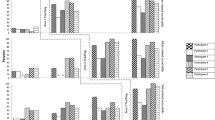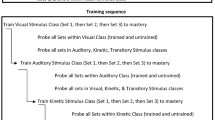Abstract
Adolescents and young adults with autism spectrum disorders (ASD) have persistent difficulty developing and generalizing social communication and interaction skills. Emerging research has demonstrated that people with ASD have benefited from strategies that embed multiple-exemplar training (MET) to increase generalization of social skills. However, to date, no systematic review has examined the effects of MET on stimulus or response generalization of social skills. As such, the purpose of the current study was to analyze the effects of MET on generalization of social skills with people aged 13–30 diagnosed with ASD. We reviewed 11 studies; results suggested that MET was effective for producing stimulus generalization of social skills.

Similar content being viewed by others
References
* denotes studies included in the review
*Breen, C., Haring, T., Pitts-Conway, V., & Gaylord-Ross, R. (1985). The training and generalization of social interaction during breaktime at two job sites in the natural environment. The Association for Persons with Severe Handicaps, 10, 41–50. https://doi.org/10.1177/154079698501000105
Baer, D. M., Peterson, R. F., & Sherman, J. A. (1967). The development of imitation by reinforcing behavioral similarity to a model. Journal of the Experimental Analysis of Behavior, 10(5), 405–416. https://doi.org/10.1901/jeab.1967.10-405
Byrne, B. L., Rehfeldt, R., & Aguirre, A. A. (2014). Evaluating the effectiveness of the stimulus pairing observation procedure and multiple exemplar instruction on tact and listener responses in children with autism. The Analysis of Verbal Behavior, 30, 160–169. https://doi.org/10.1007/s40616-014-0020-0
Cooper, H., Hedges, L., & Valentine, J. (2019). Research synthesis and meta-analysis: A step-by-step approach (3rd ed.). Sage.
*Day-Watkins, J., Murray, R., & Connell, J. E. (2014). Teaching helping to adolescents with autism. Journal of Applied Behavior Analysis, 47, 850–855. https://doi.org/10.1002/jaba.156
Erhard, P., & Falcomata, T. S. (in press). Generalization. In J. L. Matson (Ed.), Applied Behavior Analysis: A Comprehensive Handbook. Springer.
Erhard, P., Falcomata, T. S., & Harmon, T. (2019). Behavioral skills training. In F. R. Volkmar (Ed.), Encyclopedia of Autism Spectrum Disorders (2nd ed.). Springer. https://doi.org/10.1007/978-1-4614-6435-8
Falcomata, T. S., & Wacker, D. P. (2013). On the use of strategies for programming generalization during functional communication training: A review of the literature. Journal of Developmental and Physical Disabilities, 25(1), 5–15. https://doi.org/10.1007/s10882-012-9311-3
Garcia-Albea, E., Reeve, S. A., Brothers, K. J., & Reeve, K. F. (2014). Using audio script fading and multiple-exemplar training to increase vocal interactions in children with autism. Journal of Applied Behavior Analysis, 47(2), 325–343. https://doi.org/10.1002/jaba.125
Greer, R. D., Yaun, L., & Gautreaux, G. (2005). Novel dictation and intraverbal responses as a function of a multiple exemplar instructional history. The Analysis of Verbal Behavior, 21(1), 99–116. https://doi.org/10.1007/bf03393012
Greer, R. D. & Ross, D. E. (2008). Verbal behavior analysis: Inducing and expanding new verbal capabilities in children with language delays. Pearson.
Gresham, F. (2002). Best practices in social skills training. In A. Thomas & J. Grimes (Eds.), Best practices in school psychology (Vol. 4, pp. 1041–1056). National Association of School Psychologists.
Gresham, F. M. (1986). Conceptual issues in the assessment of social competence. In P. S. Strain, M. J. Guralnick, & H. M. Walker (Eds.), Children’s social behavior: Development, assessment, and modification (pp. 143–179). Elsevier.
*Grob, C. M., Lerman, D. C., Langlinais, C. A., & Villante, N. K. (2019). Assessing and teaching job-related social skills to adults with autism spectrum disorder. Journal of Applied Behavior Analysis, 52, 150–172. https://doi.org/10.1002/jaba.503
Hartup, W. W. (1989). Social relationships and their developmental significance. American Psychologist, 44(2), 120–126. https://doi.org/10.1037/0003-066X.44.2.120
Holth, P. (2017). Multiple exemplar training: Some strengths and limitations. Behavior Analyst, 40, 225–241. https://doi.org/10.1007/s40614-017-0083-z
Hong, E. R., Kawaminami, S., Neely, L., Morin, K., Davis, J. L., & Gong, L. (2018). Tablet-based intervention for individuals with ASD: Evidence of generalization and maintenance effects. Research in Developmental Disabilities, 79, 130–141. https://doi.org/10.1016/j.ridd.2018.01.014
*Hood, S. A., Luczynski, K. C., & Mitteer, D. R. (2017). Toward meaningful outcomes in teaching conversation and greeting skills with individuals with autism spectrum disorder. Journal of Applied Behavior Analysis, 50(3), 459–486. https://doi.org/10.1002/jaba.388
*Hughes, C., Harmer, M. L., Killian, D. J., & Niarhos, F. (1995). The effects of multiple-exemplar self-instructional training on high school students’ generalized conversational interactions. Journal of Applied Behavior Analysis, 28(2), 201–218. https://doi.org/10.1901/jaba.1995.28-201
Iovannone, R., Dunlap, G., Huber, H., & Kincaid, D. (2003). Effective educational practices for students with autism spectrum disorders. Focus on Autism and Other Developmental Disabilities, 18(3), 150–165. https://doi.org/10.1177/10883576030180030301
LaFrance, D. L., & Tarbox, J. (2020). The importance of multiple exemplar instruction in the establishment of novel verbal behavior. Journal of Applied Behavior Analysis, 53(1), 10–24. https://doi.org/10.1002/jaba.611
Lee, R., & Sturmey, P. (2014). The effects of script-fading and a Lag-1 schedule on varied social responding in children with autism. Research in Autism Spectrum Disorders, 8, 440–448. https://doi.org/10.1016/j.rasd.2014.01.003
Lee, R., McComas, J., & Jawor, J. (2002). The effects of differential and lag reinforcement schedules on varied verbal responding by individuals with autism. Journal of Applied Behavior Analysis, 35, 391–402. https://doi.org/10.1901/jaba.2002.35-391
Marzullo-Kerth, D., Reeve, S. A., Reeve, K. F., & Townsend, D. B. (2011). Using multiple-exemplar training to teach a generalized repertoire of sharing to children with autism. Journal of Applied Behavior Analysis, 44(2), 279–294. https://doi.org/10.1901/jaba.2011.44-279
McClintock, K., Hall, S., & Oliver, C. (2003). Risk markers associated with challenging behaviours in people with intellectual disabilities: A meta-analytic study. Journal of Intellectual Disability Research, 47, 405–416. https://doi.org/10.1046/j.1365-2788.2003.00517.x
Merrell, K. W., & Gimpel, G. (2014). Social skills of children and adolescents: Conceptualization, assessment, treatment. Psychology Press.
Miltenberger, R. G. (1997). Behavior modification: Principles and procedures. Thomson Brooks/Cole Publishing Company.
*Najdowski, A. C., Bergstrom, R., Tarbox, J., & Clair, M. S. (2017). Teaching children with autism to respond to disguised mands. Journal of Applied Behavior Analysis, 50, 733–743. https://doi.org/10.1002/jaba.413
Nangle, D. W., Grover, R. L., Holleb, L. J., Cassano, M., & Fales, J. (2010). Defining competence and identifying target skills. In D. W. Nangle, D. J. Hansen, C. A. Erdley, & P. J. Norton (Eds.), Practitioner’s guide to empirically based measures of social skills. Springer.
Neely, L., Garcia, E., Bankston, B., & Green, A. (2018). Generalization and maintenance of functional communication training for individuals with developmental disabilities: A systematic and quality review. Research in Developmental Disabilities, 79, 116–129. https://doi.org/10.1016/j.ridd.2018.02.002
Neely, L. C., Ganz, J. B., Davis, J. L., Boles, M. B., Hong, E. R., Ninci, J., & Gilliland, W. D. (2016). Generalization and maintenance of functional living skills for individuals with autism spectrum disorder: A review and meta-analysis. Review Journal of Autism and Developmental Disorders, 3, 37–47. https://doi.org/10.1007/s40489-015-0064-7
Nuzzolo-Gomez, R., & Greer, R. D. (2004). Emergence of untaught mands or tacts of novel adjective-object pairs as a function of instructional history. The Analysis of Verbal Behavior, 20(1), 63–76. https://doi.org/10.1007/bf03392995
Olaff, H. S., Ona, H. N., & Holth, P. (2017). Establishment of naming in children with autism through multiple response-exemplar training. Behavioral Development Bulletin, 22, 67–85. https://doi.org/10.1037/bdb0000044
Ouzzani, M., Hammady, H., Fedorowicz, Z., & Elmagarmid, A. (2016). Rayyan — A web and mobile app for systematic reviews. Systematic Reviews, 5, 210. https://doi.org/10.1186/s13643-016-0384-4
Center for Disease Control and Prevention (2020). Prevalence of autism spectrum disorder among children aged 8 years — Autism and developmental disabilities monitoring network, 11 sites, United States, 2016. Morbidity and Mortality Weekly Report. Surveillance Summaries, 69, 1–12. https://doi.org/10.15585/mmwr.ss6904a1
American Psychiatric Association. (2013). Diagnostic and statistical manual of mental disorders (5th ed.). https://doi.org/10.1176/appi.books.9780890425596
*Radley, K. C., Moore, J. W., Dart, E. H., Ford, W. B., & Helbig, K. A. (2019). The effects of lag schedules of reinforcement on social skill accuracy and variability. Focus on Autism and Other Developmental Disabilities, 34, 67–80. https://doi.org/10.1177/1088357618811608
Ranick, J., Persicke, A., Tarbox, J., & Kornack, J. A. (2013). Teaching children with autism to detect and respond to deceptive statements. Research in Autism Spectrum Disorders, 7(4), 503–508. https://doi.org/10.1016/j.rasd.2012.12.001
Rankin, J. A., Weber, R. J., Kang, E., & Lerner, M. D. (2016). Parent and self-reported social skills importance in autism spectrum disorder. Journal of Autism and Developmental Disorders, 46(1), 273–286. https://doi.org/10.1007/s10803-015-2574-7
Reichow, B. (2011). Development, procedures, and application of the evaluative method for determining evidence-based practices in autism. In. B. Reichow, P. Doehring, D.V. Cicchetti, & F. R. Volkmar (Eds.), Evidence-based practices and treatments for children with autism. Springer Science+Business Media, LLC.
Rimland, B. (1964). Infantile autism: The syndrome and its implications for a neural theory of behavior. New York, NY: Appleton Century Croft.
*Rozenblat, E., Reeve, K. F., Townsend, D. B., Reeve, S. A., & DeBar, R. M. (2019). Teaching joint attention skills to adolescents and young adults with autism using multiple exemplars and script-fading procedures. Behavioral Interventions, 34, 504–524. https://doi.org/10.1002/bin.1682
Schnell, L. K., Vladescu, J. C., Kodak, T., & Nottingham, C. L. (2018). Comparing procedures on the acquisition and generalization of tacts for children with autism spectrum disorder. Journal of Applied Behavior Analysis, 51, 769–783. https://doi.org/10.1002/jaba.480
Schreibman, L., Koegel, R. L. (2005). Training for parents of children with autism: Pivotal responses, generalization, and individualization of interventions. In E. D. Hibbs & P. S. Jensen (Eds.), Psychosocial treatment for child and adolescent disorders: Empirically based strategies for clinical practice (2nd ed., pp. 605–631). American Psychological Association.
Schroeder, G. L., & Baer, D. M. (1972). Effects of concurrent and serial training on generalized vocal imitation in retarded children. Developmental Psychology, 6, 293–301. https://doi.org/10.1037/h0032121
Scruggs, T., Mastropieri, M. A., & Casto, G. (1987). The quantitative synthesis of single-subject research. Remedial and Special Education (RASE), 8, 34–38.
Silbaugh, B., Falcomata, T., & Ferguson, R. (2018). Effects of a lag schedule of reinforcement with progressive time delay on topographical mand variability in children with autism. Developmental Neurorehabilitation: Advances in Autism, 21, 166–177. https://doi.org/10.1080/17518423.2017.1369190
*Stauch, T. A., Plavnick, J. B., Sankar, S., & Gallagher, A. C. (2018). Teaching social perception skills to adolescents with autism and intellectual disabilities using video-based group instruction. Journal of Applied Behavior Analysis, 51, 647–666. https://doi.org/10.1002/jaba.473
Stokes, T. F., & Baer, D. M. (1977). An implicit technology of generalization. Journal of Applied Behavior Analysis, 10, 349–367. https://doi.org/10.1901/jaba.1977.10-349
Stokes, T. F., & Osnes, P. G. (1989). An operant pursuit of generalization. Behavior Therapy, 20, 337–355. https://doi.org/10.1016/j.beth.2016.08.012
*Walsh, E., Holloway, J., Lydon, H., McGrath, A., & Cunningham, T. (2019). An exploration of the performance and generalization outcomes of a social skills intervention for adults with autism and intellectual disabilities. Advances in Neurodevelopmental Disorders, 3, 372–385. https://doi.org/10.1007/s41252-019-00125-x
Welsh, F., Najdowski, A. C., Strauss, D., Gallegos, L., & Fullen, J. A. (2019). Teaching a perspective-taking component skill to children with autism in the natural environment. Journal of Applied Behavior Analysis, 52(2), 439–450. https://doi.org/10.1002/jaba.523
Wolfe, K., Pound, S., McCammon, M. N., Chezan, L. C., & Drasgow, E. (2019). A systematic review of interventions to promote varied social-communication behavior in individuals with autism spectrum disorder. Behavior Modification, 43(6), 790–818. https://doi.org/10.1177/0145445519859803
Wolstencroft, J., Robinson, L., Srinivasan, R., Kerry, E., Mandy, W., & Skuse, D. (2018). A systematic review of group social skills interventions, and meta-analysis of outcomes, for children with high functioning ASD. Journal of Autism and Developmental Disorders, 48(7), 2293–2307. https://doi.org/10.1007/s10803-018-3485-1
Wunderlich, K. L., Vollmer, T. R., Donaldson, J. M., & Phillips, C. L. (2014). Effects of serial and concurrent training on acquisition and generalization. Journal of Applied Behavior Analysis, 47, 723–737. https://doi.org/10.1002/jaba.154
*Yamamoto, S., & Isawa, S. (2019). Effects of textual prompts and feedback on social niceties of adolescents with autism spectrum disorder in a simulated workplace. Journal of Applied Behavior Analysis, 1–15. https://doi.org/10.1002/jaba.667
Author information
Authors and Affiliations
Corresponding authors
Ethics declarations
Conflict of interest
The authors declare no competing interests.
Additional information
Publisher's note
Springer Nature remains neutral with regard to jurisdictional claims in published maps and institutional affiliations.
Rights and permissions
About this article
Cite this article
Erhard, P., Falcomata, T.S., Oshinski, M. et al. The Effects of Multiple-Exemplar Training on Generalization of Social Skills with Adolescents and Young Adults with Autism: a Systematic Review. Rev J Autism Dev Disord 11, 66–85 (2024). https://doi.org/10.1007/s40489-022-00328-4
Received:
Accepted:
Published:
Issue Date:
DOI: https://doi.org/10.1007/s40489-022-00328-4




